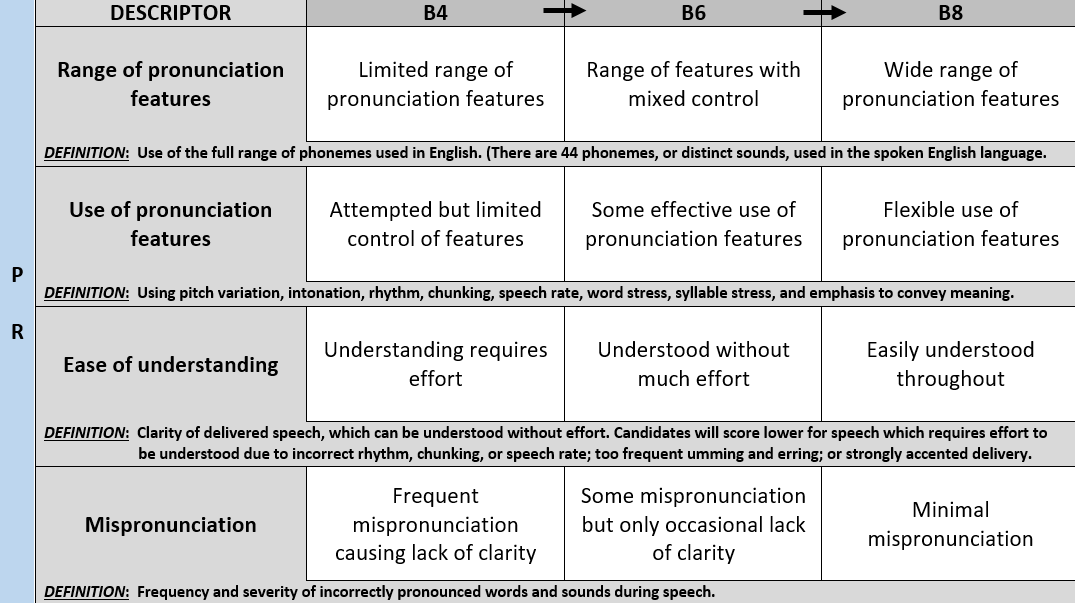The Listening Test and Reading Test are marked by qualified IELTS administrators who manually score your answer sheet out of 40 (1 mark for each correct answer). Your score is then converted to a band on the IELTS 9-band scale. You can be awarded a full or half-band score, just as in the speaking and writing tests.
The Speaking and Writing elements of the IELTS test are graded by qualified IELTS examiners using the official IELTS Speaking and Writing Assessment Rubrics. The assessment rubrics allow the examiner to numerically rate your language competency according to a fixed, pre-specified list of descriptors.
The descriptive statements summarising a candidate's language ability for IELTS Band scores 4 - 9 are shown in the table below.

If you are going to achieve the band score you desire, it is essential that you are familiar with the specific descriptors which constitute the assessment criteria for each part of the IELTS test. You can then focus on and improve each skill until you are confident and ready to sit the test.
This is important information that most IELTS test takers do not know about, or take the time to understand properly.
LISTENING & READING ASSESSMENT
The Reading and Listening Tests are graded using a scoring system that varies to a small degree with each IELTS test.
Broadly speaking, you need to score at least 23/40 for a Band 6 in the Listening and Reading Test, and at least 30/40 for a Band 7 award.
The exact cut-off score for each band varies according to the average of the inverse square of the sum total of global IELTS candidate achievement on any specific IELTS testing session, set and determined on a test-by-test basis through the application of complex Cambridge CIE algorithmic analysis of worldwide IELTS test scores...
- In other words: Forget about it, and keep practicing until you can consistently score 30/40 or above for the Listening and Reading Tests.
During the Speaking Test interview the examiner is using a rubric very similar to the one shown below.
You can see the rubric is split into 4 columns. Each column represents one of the four speaking assessment criteria:
- FLUENCY & COHERENCE (FLC)
- LEXICAL RESOURCE (LR)
- GRAMMATICAL RANGE & ACCURACY (GRA)
- PRONUNCIATION (PR)

Under each of these headings you will see a list of bullet-pointed descriptors which describe the parts of speech which must be demonstrated by the candidate in order to achieve the corresponding band score rating.
The IELTS interviewer has all of these criteria in mind and, as the interview progresses, is looking for examples of each in order to be able to score your performance effectively.
To be awarded a particular band level rating you must be able to demonstrate all of the descriptors specified at the corresponding band level.
Fluency & Coherence is a measure of how fluently you are able to communicate. There are three main descriptors within the FLC criterion that the examiner is focusing on: your ability to speak at length; the frequency of hesitation, repetition and self-correction in your language; and your use of connective features such as pronouns, conjunctions and spoken discourse markers.
Take a look at how these three descriptors change from Band 5 (B5) up to Band 7 (B7):

Focus on and practice your FLC skills with the Level 3 InsideIELTS Virtual Examiner now!
Lexical Resource is the level and range of vocabulary that you are able to use. The examiner is analysing your language to guage the extent of your vocabulary resource; the range and accuracy of your language; and your ability to make use of paraphrase in an extended response.
Take a look at how these three descriptors change from Band 5 (B5) up to Band 7 (B7):

Focus on and practice your LR skills with the Level 4 InsideIELTS Virtual Examiner now!
Grammatical Range and Accuracy measures the range of different grammatical forms and tenses that you are able to use correctly. The examiner is listening to your answers to determine the range of simple, compound and complex structures you make use of and how often grammatical errors occur in your response.
Take a look at how these three descriptors change from Band 5 (B5) up to Band 7 (B7):

Practice speaking with the InsideIELTS Virtual Examiner to increase your GRA score now!
The fourth criteria the examiner is assessing is pronunciation: your ability to make correct use of rhythm, stress and intonation in your speech. Mispronunciation and ease of understanding for the listener are also factors being taken into consideration.
Take a look at how these three descriptors change from Band 4 (B4) up to Band 8 (B8):

* If you examine the speaking rubric you will see that to achieve a Band 7 for PR you must fulfill all of the Band 6 criteria and some, but not all, of the criteria from Band 8.
Focus on and practice your PR skills with the Level 2 InsideIELTS Virtual Examiner now!
The IELTS writing examination lasts for 60 minutes. The test paper is split into two parts:
The tasks are not equally weighted in terms of marks, so you're advised to spend around 20 minutes on Task 1 and 40 minutes on Task 2.
TASK 1
Here is the (public version) of the OFFICIAL IELTS WRITING TEST ASSESSMENT RUBRIC for Task 1:

You can see that the Task 1 writing rubric is also split into four columns, each focusing on a different component of written communication:
- TASK ACHIEVEMENT (TA)*
- COHERENCE & COHESION (CC)
- LEXICAL RESOURCE (LR)
- GRAMMATICAL RANGE & ACCURACY (GRA)
(*The Task 1 and Task 2 rubrics differ only in regard to the first assessment component: Task Achievement (TA) in Task 1 and Task Response (TR) in Task 2.)
Under the headings in each column you will see a list of bullet-pointed descriptors which describe the writing features which must be demonstrated by the candidate in order to achieve the corresponding band score rating.
The IELTS writing test assessor has all of these criteria in mind and, as he/she reads through your written response, is looking for examples of each in order to accurately assess and grade the level of your writing ability.
To be awarded a particular band level rating you must be able to demonstrate all of the descriptors specified at the corresponding band level.
Task Achievement in Writing Task 1 measures how well you fulfill the requirements of the question.
For the Academic test your job is to, 'Summarise the information by selecting and reporting the main features, and make comparisons where relevant'.
For the General Training test your job is to, 'Write a letter to ________, and describe/explain/say ________'.
Take a look at how these three descriptors change from Band 5 (B5) up to Band 7 (B7):

These 3 descriptors make up the basis of the TA assessment criteria.
Coherence and cohesion is a measure of how well your report or letter is structured in terms of organisation of ideas, clarity of information given, and ease of understanding for the reader.
Take a look at how these three descriptors change from Band 5 (B5) up to Band 7 (B7):
.png)
These 3 descriptors make up the basis of the CC assessment criteria.
Lexical resource is concerned with vocabulary. For a higher level score you need to use a wide range of vocabulary, choose your words appropriately, and try to make use of less-common words and phrases.
Take a look at how these five descriptors change from Band 5 (B5) up to Band 7 (B7):

These 5 descriptors make up the basis of the LR assessment criteria.
The fourth criteria the examiner is assessing when he/she marks your Task 1 response is Grammatical Range and Accuracy. To achieve an upper level band score for GRA you need to use a wide range of different grammatical structures and try to minimise the number of grammar and punctuation errors in your writing.
Take a look at how these 2 descriptors change from Band 5 (B5) up to Band 7 (B7):

These 2 descriptors make up the basis of the GRA assessment criteria.
TASK 2
Now let's take a look at the public version of the OFFICIAL IELTS ASSESSMENT WRITING TEST RUBRIC for Task 2:

You can see that the Task 2 writing rubric is similarly split into four columns:
Task Response in Writing Task 2 measures how well you address the requirements of the essay question.
Take a look at how these three descriptors change from Band 5 (B5) up to Band 7 (B7):

These 3 descriptors make up the basis of the TR assessment criteria.
Coherence and cohesion is a measure of how well your essay is structured in terms of organisation of ideas, clarity of information given, and ease of understanding for the reader.
Take a look at how these four descriptors change from Band 5 (B5) up to Band 7 (B7):
.png)
These 4 descriptors make up the basis of the Task 2 CC assessment criteria.
Lexical resource is concerned with vocabulary. For a higher level score you need to use a wide range of vocabulary, choose your words appropriately and try to make use of less common words and phrases.
Take a look at how these five descriptors change from Band 5 (B5) up to Band 7 (B7):

These 5 descriptors make up the basis of the LR assessment criteria.
The fourth criteria the examiner is assessing when he/she marks your Task 2 essay is Grammatical Range and Accuracy. To achieve an upper level band score for GRA you need to use a wide range of different grammatical structures and try to minimise the number of grammar and punctuation errors in your writing.
Take a look at how these 2 descriptors change from Band 5 (B5) up to Band 7 (B7):

These 2 descriptors make up the basis of the GRA assessment criteria.
Familiarise yourself with all of the IELTS assessment criteria with the unique InsideIELTS step-wise learning program.
Learn at your own pace and study at any time of day or night with the InsideIELTS Virtual Examiner.


